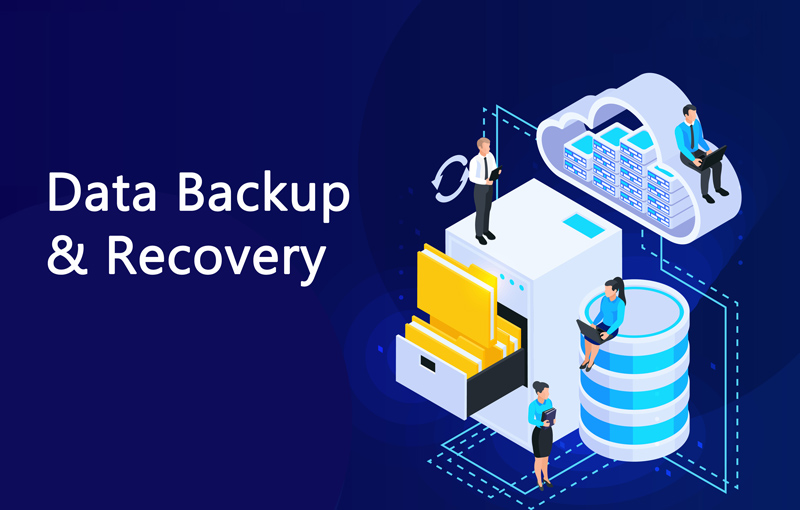Data Backup and Recovery: Types & Methods
Data is one of the most vital assets out there. Businesses like yours must be able to protect data as if their lives depend on it. Because there are plenty of situations that can cause data to be lost, stolen, or irretrievable - depending on what happened.
This guide will cover the concept of data backup and recovery. These are two crucial approaches for data security and protection: which also include preprocessing and post-processing. You'll learn why it's such an important thing and what backup and recovery can handle in terms of the number of situations where data can be threatened. Finally, and the different types of backup and recovery along with the methods you can use to your advantage.
Part 1: Explanation of Data Backup and Recovery
So what is data backup and recovery? In an enterprise setting, data security is paramount. Especially when you are handling large amounts of data with your computer system. The concept of data backup and recovery is straightforward.
On one end, you have the backup process - which entails backing up any piece of vital data that can be placed in storage devices like a cloud-based software. This can be useful since you can access it from just about any computer so long as you have the credentials.

Likewise, the recovery process will consist of recovering the data in the aftermath of a situation. If the data is backed up accordingly, you should have no trouble recovering all of it. With that said, let's take a look at some tips on what data is referred to:
● Files and documents stored on a computer will consist of data that you can use for your customers and clients. This will include contact information, customer surveys, or any other pertinent documentations
● Databases will contain information similar to what we've already mentioned like contact information, how far along the sales process they may be, their financial information, and others. These pieces of data (like the rest of the list we'll go over) must be protected accordingly with regular backups
● Contents of email and other communications qualify as data. If you can, see if you can utilize an email platform that offers encryption - which will keep data and communication with your customers and those inside your company safe. This also includes attachments sent in the emails as well
● Software and applications that can run the business as well as its necessary functions will contain certain amounts of data - even though it's technically data itself
● Operating systems such as files, drivers, and configuration files will often be stored. These can also include installation files of past updates - which can remain on your computer until you either back it up or perform a disk cleanup that will create space
● User data includes login information assuming your customers have such accounts to login to the site. You will need to protect them by implementing certain features such as two-factor authentication (2FA)
Part 2: Situations that Data Backup and Recovery Handle
In this following section, we're going to take a look at the common situations where data backup and recovery shine the brightest. It is important to be prepared for such moments like this. Some of them are preventable while others may occur rarely while being out of your own control.
Let's take a look now at the following situations where data backup and recovery handle apply:

1 Hardware Failures
If your data is stored in specific hardware, you may have a difficult time recovering the data (if you're lucky). Otherwise, it may be gone forever. This is one more reason why storing it on a cloud service will be your best option.
Hardware failure can occur if you do not perform regular maintenance. It may also fail due to defects. Most of the time, such failures may be preventable thanks to regular maintenance.
2 Accidental Deletion
Human error is also another reason why data can be lost. Accidental deletion is one such situation. For this reason, backup and data recovery will ensure everything is in place.
That is just in case someone messes up and deletes something. Yes, it happens all the time, especially when you're cleaning out old unwanted files.
3 Software Errors
These may or may not occur outside of your control. A software error may be triggered due to an issue with the algorithm and overall functionality. Another reason software errors may exist may be human error - especially when it's changing settings or deleting something that is critical to its entire functioning process.
4 Power Outages or Power Surges
Power outages and surges can happen so fast. You may also experience power outages for longer periods - even in times of a natural disaster or inclement weather. While a generator may be useful to keep the power on, it may not be enough.
That's because it may take some time for said generator to kick on. Meaning you still risk losing data. Therefore, data backup and recovery will still be performed on a regular basis.
Power outages can happen at any time, even with no warning at all. Someone may hit a utility pole with a car and bring down wires in the process. Or a transformer nearby will explode knocking out power to the entire block.
5 Cyber Attacks
Of course, we take these very seriously. Cyber attacks can be preventable through various means such as encryption, educating your team members to avoid fake links or suspicious files and emails, or implementing a suite of cyber protection tools that can protect you from viruses, malware, phishing attacks, and so much more.
Data backup recovery will be important in the event of cyber attacks. Losing data will cost you a ton of money and even trust from your customers because you didn't do enough to protect it from those who were looking to steal it and sell it on the dark web.
6 Data Corruption
How does this happen? Data corruption can be caused by various factors. This can include overwriting files, mishandling of the data migration process, and even cyberattacks among others.
You could be transferring data from one storage space to another and the power may go out, causing the transfer to fail while corrupting the data in the process. Regardless, data backup and recovery will always be your best friend - especially if you're doing it regularly.
7 System Updates or Migrations
While these may sound like good things to do, there may be times where such updates can hurt your data. System updates may be automated as well. So should your data backup recovery methods.
Migration pertains to other hardware that is not your designated storage space for data backup and recovery. You could lose certain pieces of data in the process. If you plan on moving data around, back it up first - always.
Part 3: 3 Common Types of Data Backup
There are three types of data backup: full, incremental, and differential. We will break down each time including the required storage space, how long it will take, how frequent it should be done, impact of the performance, and cost. Let's take a look at the following table down below:
● Full Backup: The most basic approach where all your data is backed up into one location.
● Incremental Backup: Includes a backup of all files including any changes from the previous backup.
● Differential Backup: Backs up just copies of all files that have been changed since the previous full backup.
Full Backup | Incremental Backup | Differential Backup | |
|---|---|---|---|
Storage Space Required | Follow the amount of files you have on your current system and double it. Ex: If you're storing 200 GB of data, aim for 400 GB of backup storage. | This may include smaller amounts of space compared to full backups. However, consider space larger than a fraction of the total amount of files stored. A GB a day may be sufficient enough. | May depend on your numbers including the amount of data stored and how many hours it will take between backup periods. |
Time It Takes | Depends on the speed of your connection and amount of data. For example, if the speed is 5Mbps and you have 100 GB of data, it can take at least 48 hours. | Can take at least a few hours. | Can take anywhere from 5 minutes to a few hours depending on several factors. |
Frequency | Every 30 days. | Daily or every few minutes depending on the volatility of data. | 12-24 hours. |
Impact of Performance | There may be some impact dependent on. | You can still be able to run your system without issue since it uses fewer sources. | May not negatively affect performance at all. |
Cost | Dependent on the platform. But the most expensive option regardless. | Middle of the road - dependent on platform. | The most cost-efficient option. |
Part 4: 5 Common Types of Data Recovery
Now that you know the three common types of data backup, let's switch gears and discuss data recovery. There are five types to go over and what makes them important. Here's a look at the following:
1. Built-in Recovery: Standard with many operating systems that will help restore their system and recover lost files. They include system restore points, which will roll back your system to a time where it was functioning properly. Useful for troubleshooting situations.
2. File System Recovery: This will pertain to repairing and restoring the file system structure on your storage devices. You can be able to organize and manage data on said devices. These can be useful if the system contains corrupted data that would otherwise be inaccessible.
3. Disk/Partition Recovery: This entails the restoration of data from damaged or lost partitions on your storage device. Instances such as corruption, formatting, or accidental deletion will be your issues where this recovery type will come into play.
4. Physical Damage Recovery: This focuses on the retrieval of data from devices that have sustained physical damage. This can also include hard drive malfunctions, damaged sectors, or other issues with the hardware.
5. RAID Recovery: RAID stands for Redundant Array of Independent Disks. This recovery type will be used for restoring data from what is known as a RAID array. It will be useful for reconstructing data in the event of any disk failures in the array itself.
Part 5: Methods of Data Recovery and Backup
Data Backup Methods
Local Backup
This will include storing copies of data on physical storage like USB drives, external HDDs, or NAS devices. These will be located close to the original data source and will serve as a quick and convenient solution to data recovery and backup regardless of any incidents that may have occurred.
Network Backup
With a network backup, you'll be able to use an NAS device or a backup server. You can connect multiple devices to a centralized location that is connected to a local network. This backup will be useful if you intend to store data that originated from numerous devices.
Cloud Backup
One of the most popular options on the market today. You'll use remote servers hosted by third parties to store your most important data. You can access this data just about anywhere as long as you have the login credentials.
Offsite Backup
Offsite backup includes storing backup copies of your data to a different geographical location from the original source. Physical storage at a different location can be used or even cloud-based storage, whichever will make the best sense for you.
Mirror Backup
Also known as disk mirroring. The method lives up to the name by creating an exact replica of the whole data set on a different storage platform. Changes to the original data will be mirrored instantly and in real time.

Data Recovery Methods
These methods will help minimize downtime, protect you against various situations, and ensure that you have complied with any regulations pertaining to data storage and recovery. There are two methods including the following:
Restore from Backup
This includes the retrieval and reinstatement of data copies that have been previously backed up. You'll be able to do this by way of local devices, NAS devices, and other methods of data recovery and backup that we have listed earlier.
Data Recovery and Software Services
Specialized tools or services will be used to recover lost or inaccessible data from your devices. This can include data that may have been deleted, formatted, or corrupted. This will be an excellent option if no traditional methods are available.
Part 6: Why is Data Backup and Security Crucial for Enterprises?
Enterprises handle large amounts of data. Which means a loss of data may not only be costly, but it will also lead to many of their customers and clients jumping ship due to mistrust. Word travels fast - especially about bad news regarding data being compromised.
One good reason why you need to hold data recovery and backup to a high level of importance. Also, protecting your system from all kinds of disasters and cyberattacks are a must.
Conclusion
You now have an understanding of the different types and methods of data backup and recovery. Make sure that you perform the necessary backups as often as possible. You also want to choose a recovery method that will work to your advantage while addressing your most critical needs and preferences.
Still need help? Submit a request >>

